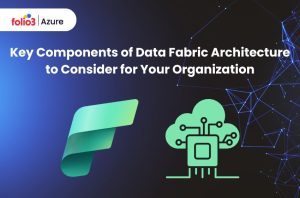Table of Contents
ToggleIt’s estimated that an enormous 2.5 quintillion bytes of data are generated every day globally! Hence, efficient data management and secure access are a necessity and foundation for organizations.
Today, organizations are utilizing advanced on-premise and cloud technologies to use their data to their benefit and stay competitive. Azure is a globally preferred platform for hosting databases in the cloud, and Azure Virtual Network (VNet) is a solution that allows you to create a secure network to run Virtual Machines and applications in the cloud.
When combined with Microsoft Fabric, it provides powerful data management and processing capabilities. Thus, the integration becomes a powerful duo, enabling smooth data flow.
The VNet Data Gateway with Fabric is fundamental in this process, enabling secure data transmission between your on-premises systems and Azure services.
Let’s help you understand how to set up and use this connection for your business’s data needs.
Accelerate smart decisions with Microsoft Fabric's unified data and AI analytics.

Use Cases for Connecting Microsoft Fabric to Azure VNet
Connecting Microsoft Fabric to an Azure VNet can be a massive transformation for organizations that want to secure their data workflows. Here are some important use cases that highlight the importance of using a VNet Data Gateway for Fabric in real-world scenarios.
Scenario 1: Connecting On-Premises Data Sources to Azure Services
Several organizations use old systems that store their critical data on-premises. When shifting to the cloud services such as Azure it is essential to connect these systems securely. The VNet Data Gateway with Fabric lets you connect your on-premises data sources with Azure services while ensuring your data remains safe and secure during transmission.
The VNet Data Gateway infrastructure guarantees a dependable and secure connection, avoiding exposure to public networks, whether you’re connecting databases, analytics tools, or custom applications.
Scenario 2: Utilizing Microsoft Fabric for Secure Data Ingestion
Organizations handling vast amounts of data, especially those associated with industries with strict regulations, require a secure and isolated environment for data ingestion and processing.
Using VNet Data Gateway, you can warrant that all data entering Azure from your on-premises environment is securely processed within a restricted network.
Microsoft Fabric, coupled with the VNet Data Gateway to Fabric, guarantees that data is processed efficiently and that unauthorized access is prevented.
Scenario 3: Ensuring Compliance and Security for Sensitive Data
Data privacy regulations, including GDPR and HIPAA, require strict measures to guarantee data security and compliance. You must isolate your data flows from the public internet while handling confidential information.
By utilizing the VNet Data Gateway for production to route data through an isolated network, you can conform to regulatory requirements and guarantee that sensitive data is encrypted and securely transmitted.
This is very important for industries where data breaches can have major repercussions, such as government services, healthcare, and finance.
Steps to Setting Up Microsoft Fabric VNet Data Gateway
Configuring the VNet Data Gateway for Fabric is crucial in ensuring secure and dependable data flows between your on-premises infrastructure and Azure services.
Let’s discuss the steps of this important process one by one:
Step 1: Create and Configure an Azure Virtual Network
The initial step in setting up your gateway is to create an Azure Virtual Network. A Virtual Network is the foundation for establishing secure communication between your on-premises systems and Azure services. During this step, you must do the following:
- Define your IP address range according to your organization’s networking requirements.
- Create subnets to segment various parts of your network, such as front-end and back-end services.
- Configure Network Security Groups (NSGs) to control traffic flow in your VNet. These rules let you define exactly which IP addresses and ports are allowed access.
Step 2: Set Up the Microsoft Fabric VNet Data Gateway
After setting up your VNet, you must now move on to employing the VNet Data Gateway for Fabric. This gateway acts as a connection between your on-premises systems and Azure, enabling secure data transfer. When deploying the gateway, do the following:
- Make sure that you have all the permissions required for both on-premises and Azure environments.
- Apply any VNet Data Gateway configuration updates to guarantee compatibility with your current setup and to get the best performance.
- Follow the steps mentioned in Microsoft’s documentation to install the gateway software and connect it correctly to your Azure VNet.
Step 3: Connecting Microsoft Fabric to the Azure VNet
You must link Microsoft Fabric to the VNet after the VNet Data Gateway infrastructure has been set up. This consists of setting up Fabric to route data using the VNet Data Gateway. To prevent your data from being exposed to the public Internet, make sure the connection is secure and that all traffic is sent through the VNet.
- Utilize Azure’s tools to check that Microsoft Fabric is correctly integrated with your VNet.
- Set up network routing to ensure data flows smoothly and efficiently between your on-premises systems and Azure.
Step 4: Test and Verify the Connection
After the VNet Data Gateway for Fabric is successfully installed and connected to your VNet, testing this connection is important. Run tests to verify data flows securely and efficiently between on-premises and cloud services. You can use helpful tools like Azure Monitor to track data traffic and detect any issues in real-time.
- Verify that the data transfer speeds remain within acceptable ranges.
- Test failover scenarios to check that the gateway can handle any disruptions.
Step 5: Monitoring and Managing the Gateway
Continually monitoring and managing your VNet Data Gateway for production is mandatory to guarantee the best performance. Thus, you must regularly monitor data traffic, gateway performance, and any possible hurdles that could adversely affect the data flow.
Azure is embedded with various monitoring tools, such as Azure Monitor and Log Analytics, which can help you monitor the health and performance of your gateway.
- Set up alerts to notify you of any performance or security issues.
- Regularly check VNet Data Gateway pricing to double-check that your setup is always cost-effective as your data volumes increase.
Best Practices for Securing and Optimizing VNet Data Gateway
When configuring and maintaining the VNet Data Gateway with Fabric, security and performance are the primary concerns. The following recommended practices will help you in securing and improving your gateway:
1. Security Recommendations
- Data Encryption: You must always encrypt data while it is being transmitted using strong encryption protocols like TLS. This guarantees that data moving via the VNet Data Gateway is always safe from unauthorized access.
- Role-Based Access Control (RBAC): Limit access to the VNet Data Gateway infrastructure by employing role-based access control. This will allow only authorized users to configure or manage the gateway.
- Regular Gateway Updates: Keep your gateway updated with the latest VNet Data Gateway configuration updates to tackle security risks and improve performance.
2. Performance Optimization
Optimizing performance is important for warranting that your VNet Data Gateway for production can handle the high influx of data without causing any delay:
- Network Latency Monitoring: Keep track of network latency to confirm that data transfers are always efficient, especially when handling massive datasets.
- Scale Gateway Resources: If your data requirements increase, adjust the resources allocated to your VNet Data Gateway infrastructure to prevent possible performance issues.
3. Cost Management
Last but not least, controlling costs is important when using the VNet Data Gateway for Fabric. Azure provides various helpful tools to let you manage and predict costs:
- Monitor Data Usage: Keep a close eye on your data transfer volumes and avoid unnecessary data movements to minimize your total costs.
- Right-Size Your Gateway: Avoid over-provisioning gateway resources by carefully scaling them according to your actual needs. Regularly review VNet Data Gateway pricing to stay within the bounds of your budget.
Conclusion
Connecting Microsoft Fabric to Azure Virtual Network by employing the VNet Data Gateway with Fabric provides you with an ultra-secure, scalable, and powerful solution for data management in hybrid environments.
By following the steps mentioned in this article, you can configure a strong gateway that will suffice your data transfer needs and also comply with strict security requirements.
As you consider your next leap forward in making your cloud infrastructure efficient, using Microsoft Fabric and Azure VNet can establish that your data is always handled securely and efficiently. If you want to improve your data management strategy, you must take the first step by exploring the endless possibilities with Microsoft Fabric.




